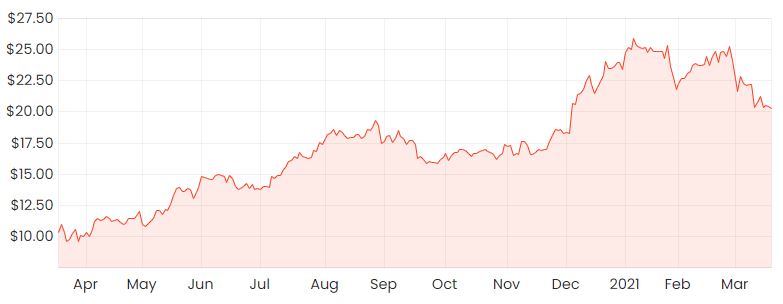A recent pullback in iron ore prices and weaker Chinese steel prices might partly explain why iron ore producer, Fortescue Metals Group Limited’s (ASX: FMG) shares have trended downwards in recent weeks.
Despite trading at significantly lower levels, Fortescue’s shares have still returned over 100% in the last 12 months, not including the $1.47 (5.9%) per share dividend recently declared in its H1 FY21 results.
FMG share price

Demand slows
Fortescue is another company that is often described as a price-taker, meaning it doesn’t have the ability to dictate the market price at which it can sell iron ore.
Other examples of price-taking ASX companies include other commodities producers such as Rio Tinto Limited (ASX: RIO) and BHP Group Ltd (ASX: BHP) which I recently wrote about here.
China imports most of their iron ore from Australia and their high steel production over the last 12 months partly explains why the iron ore price has increased to such high levels over this time.
In recent weeks, air pollution concerns in China has resulted in their government enforcing tougher compliance measures on steel mills, causing demand and the price of iron ore to pull back to US$168.2 per tonne.
Is now a good time to buy?
Remember Fortescue’s profits and therefore share price is heavily influenced by the iron ore price.
We can confirm this by taking a look at its most recent financial results. Over the last six months of operation, the amount of iron ore Fortescue shipped only increased by 2% on the prior corresponding period (pcp) and costs remained unchanged.
The only thing that significantly changed was the iron ore price, which resulted in revenue increasing by 44% to $9.3 billion and underlying net profit after tax (NPAT) jumping by 66% to $4.08 billion.
To be a buyer of Fortescue’s share today, you’d most likely be hoping the iron ore price can at least be maintained close to its current level over the short-medium term.
Some commentators seem fairly confident this may happen due to the fact an increase in production can take quite some time to catch up with demand. Production has remained fairly constant amongst the other big players like BHP and Rio Tinto.
Fortescue will eventually increase its production capacity through its Iron Bridge project, but it seems to be at least a couple of years away before production begins.
If some of these predictions turn out to be correct, Fortescue may be in for another round of impressive financial results. That’s a big emphasis on the “if” though.
I probably wouldn’t be a buyer at these levels. One of the reasons why the iron ore price has shot up in recent years is not only due to increased demand coming from China, but decreased supply from Brazilian producer Vale.
As Vale gradually ramps up production again, I think it would be logical to assume this may cause some further weakness in the iron ore price.
Other ideas
It would’ve been ideal to pick up shares in Fortescue a few years ago at a much cheaper price and ride the upside of this current commodities cycle. If you’re not looking to actively trade commodities stocks, Fortescue might not be the most appropriate choice for a typical “buy and hold” investment strategy.
I prefer a longer-term outlook and a common characteristic I look for in companies is its ability to consistently raise prices over time through most economic cycles.
The most ideal business model would be one that’s monopolistic, but they’re fairly rare to come across outside of textbook examples.
What’s more common are businesses that have high levels of pricing power. This may be because they offer such a highly rated product or service, or there might be high switching costs involved – maybe a combination of both.
Microsoft Corporation (NASDAQ: MSFT) might be one of the best examples to illustrate this.
Back in 2016 after the UK Brexit vote, the value of the pound fell by roughly 18% at the time.
As a US company selling software in pounds, this would’ve meant a significant reduction in revenue once exchanged for USD.
To ensure Microsoft didn’t underperform due to unfavourable foreign exchange (FX) movements, it simply increased the British pound prices for enterprise software by 13% to offset the appreciated USD. Needless to say, Microsoft’s customer base didn’t exactly refuse to accept this price hike and switch to a competitor…
This is a fairly rare example of a company with such immense pricing power, but even smaller software companies may have similar characteristics.
I’ve talked about Xero Limited (ASX: XRO) quite a lot because I think it might have a moderate level of pricing power, albeit quite a bit less than Microsoft.
To learn more about Xero, click here to read: Down 28% in 3 months: Are Xero (ASX: XRO) shares in bargain territory?




